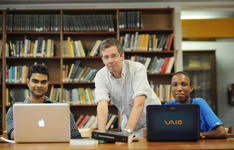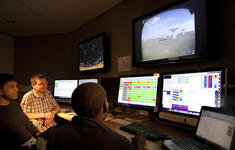Home > Science Capability Building > Human Capital Building: The Development of Africa's Skill Base Science Capability Building
Human Capital Building: The Development of Africa's Skill Base
Africa's science renaissance has reflected, and been reflected in, a growing stock of human capital throughout African societies. Radio astronomy investment, in particular, has raised both the supply of and demand for a skilled, scientifically literate workforce. As a capital injection in African economies, it has contributed to the creation and growth of a high-knowledge skills base in the region.
Radio Astronomy and the Development of Africa's Skill Base
The International Astronomical Union has highlighted the effective role of astronomy in human and economic development, in its Strategic Plan 2010-2020 "Astronomy for the Developing World". Astronomy has been an important driver behind the development of advanced technology, such as the most sensitive detectors of light and radio waves and the fastest computers. Moreover, unlike most sciences, astronomers can participate in frontier astronomical research regardless of their geographic location. Many of the cutting-edge ground-based and space facilities developed for astronomy are available for use at no cost by scientists throughout the world.
The Meerkat project is already contributing to the development of astronomical skills across Africa. Since technologies being developed for MeerKat (as well as SKA) will be commercialised in the next 10-20 years, young African people currently working on the project will find themselves in high demand around the world. Preparations for SKA have also included measures aimed at developing the indigenous skills base needed for such a project. In 2005 the South African SKA Project initiated a targeted “Youth into Science and Engineering Programme” to develop highly skilled young scientists and engineers. Young people supported by this programme will serve South Africa and African partner countries in the future in key areas of economic development, in addition to their participation in “blue skies” scientific research. In 2010, the SKA South Africa team announced a new training programme to support African students who wish to study and train in the maintenance of telescope systems.
This came as part of the broader SKA Human Capital Development programme. Since its inception, it has awarded 293 bursaries, grants, fellowships and established five research chairs dedicated to science and instrumentation of astronomy, including the MeerKat/SKA programmes and multi-wavelength astronomy. Rhodes University, Stellenbosch University, the University of Cape Town (UCT), the University of the Western Cape (UWC) and the University of the Witwatersrand (Wits) were selected to host the Research Chairs as part of the South African Research Chairs Initiative, designed to support world class research and teaching at universities across the country. Bursaries cover study for PhD, MSc, undergraduate, technician and artisan qualification. Cross-border skills development is also an increasing feature of the Human Capital base in Africa. In April of this year, South Africa announced a donation of 500,000 Rand to Mozambique for its radio telescope, in aid of skills development for the SKA Telescope.
More broadly, radio astronomy in Africa has human capital impacts beyond the fields directly associated with it. Like any large ICT project, radio astronomy projects have direct benefits to society through the training of technicians for development and operations and through the attraction of new talent to ICT in general. The construction of high-tech facilities equips civil engineers and construction workers with precious experience and skills for future employment. Communications and power engineers benefit from the valuable experience of working on the installation of the ground breaking communications and power infrastructures required for projects like MeerKAT and the SKA.
The Southern African Large Telescope (SALT) has boosted the South African economy, with local industry manufacturing around 60 per cent of the telescope's components. It has also been a boon for the country's tourism industry. In the first year after opening, the annual number of visitors to the small town of Sutherland jumped from a few hundred to over 13,000. As a result, guest houses, coffee shops and tourism-related businesses have appeared. The SALT Collateral Benefits Programme in partnership with local stakeholders has developed 'astro-tourism' activities. In Namibia, locals are taking advantage of the new interest in astronomy sparked by the High Energy Stereoscopic System. Some farmers in the area, for example, have set up small telescopes in their back gardens for visiting amateur astronomers to use.
African astronomy projects have already generated manufacturing spin-offs — extremely fast switching devices built for the HESS project are being adapted for commercial sterilisation systems because they create ozone, a strong disinfectant.
AERAP Brochure available for download here.
Coordination is provided by ISC Intelligence in Science as one of the initiators of AERAP, together with the South African Mission to the EU.
Contact: info@aerap.org or +32 2 8888 111

 Search the Website
Search the Website

